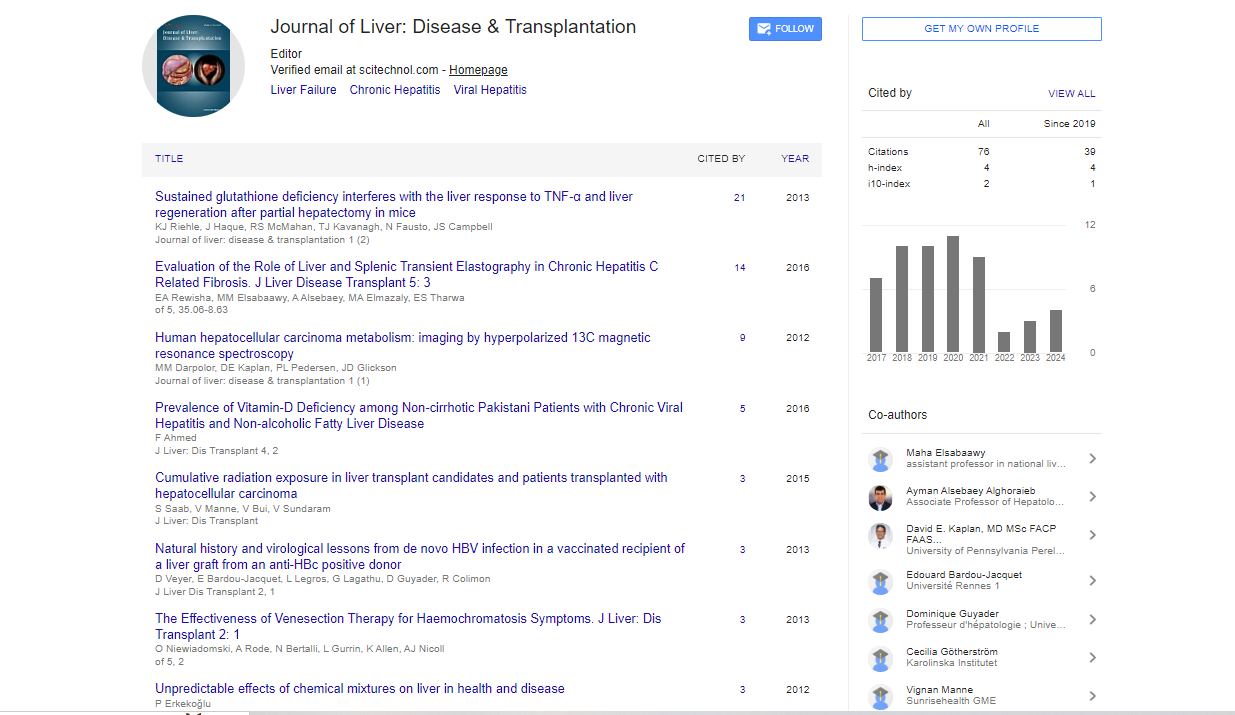Opinion Article, J Liver Disease Transplant Vol: 12 Issue: 4
Hepatocytes: Cellular Backbone in Liver Physiology, Metabolism and Detoxification
Hail Ming*
1Department of Medicine, Columbia University Irving Medical Center, New York, United States of America
*Corresponding Author: Hail Ming,
Department of Medicine, Columbia University
Irving Medical Center, New York,United States of America
E-mail: mingh@cu.edu
Received date: 20 November, 2023, Manuscript No. JLDT-23-123852;
Editor assigned date: 22 November, 2023, Pre QC No. JLDT-23-123852 (PQ);
Reviewed date: 06 December, 2023, QC No. JLDT-23-123852;
Revised date: 13 December, 2023, Manuscript No. JLDT-23-123852 (R);
Published date: 20 December, 2023, DOI: 10.36648/2325-9612.100245
Citation: Ming H (2023) Hepatocytes: Cellular Backbone in Liver Physiology, Metabolism and Detoxification. J Liver Disease Transplant 12:4.
Abstract
Description
Hepatocytes, the principal cells of the liver, play a vital role in maintaining homeostasis and ensuring the proper functioning of various metabolic processes within the body. These highly specialized cells exhibit remarkable versatility, contributing to processes such as detoxification, nutrient metabolism, and synthesis of essential proteins. Hepatocytes are polygonal-shaped cells, forming the majority of the liver tissue. Structurally, they exhibit a unique architecture that facilitates their diverse functions. The cell is characterized by a large, centrally located nucleus and abundant cytoplasm containing various organelles. The endoplasmic reticulum, particularly the smooth endoplasmic reticulum, plays a crucial role in lipid metabolism and detoxification processes within hepatocytes. Additionally, the presence of numerous mitochondria emphasizes the high energy demands associated with their metabolic activities.
One of the primary functions of hepatocytes is detoxifying harmful substances. The liver acts as a central detoxification organ, filtering blood from the digestive system before it reaches the rest of the body. Hepatocytes break down and neutralize toxins, drugs, and metabolic byproducts, preventing potential harm to other organs. Hepatocytes are central to the regulation of nutrient metabolism. They play a key role in glucose homeostasis by storing glucose as glycogen and releasing it when needed. Furthermore, hepatocytes are involved in lipid metabolism, synthesizing and secreting lipoproteins and cholesterol while also converting excess carbohydrates into fatty acids. The liver, through the activity of hepatocytes, is a major site for the synthesis of proteins. Hepatocytes produce a variety of proteins, including blood-clotting factors, albumin, and enzymes necessary for various physiological processes. Albumin, for instance, maintains osmotic pressure and transports substances in the bloodstream. Hepatocytes contribute significantly to bile production, a crucial process for digestion and absorption of fats. Bile, synthesized by hepatocytes, is stored in the gallbladder and released into the small intestine to aid in the emulsification and absorption of dietary fats. The liver stores essential vitamins and minerals, including vitamins A, D, and B12, as well as iron and copper. Hepatocytes release these stored nutrients into the bloodstream as needed, contributing to the body's overall nutritional status.
Significance of hepatocytes
Hepatocytes are integral to the regulation of various physiological parameters, contributing to the overall stability of the internal environment. Through their involvement in detoxification, nutrient metabolism, and synthesis of vital molecules, hepatocytes help maintain homeostasis within the body. The synthesis and secretion of bile by hepatocytes are essential for the breakdown and absorption of dietary fats. Without proper bile production, the digestive process would be impaired, leading to malabsorption of nutrients and potential health complications. Hepatocytes are crucial in detoxifying harmful substances, including drugs and toxins. Understanding the metabolic processes within hepatocytes is vital for drug development and ensuring the safety of pharmaceutical interventions. The regulation of glucose and lipid metabolism by hepatocytes is vital for energy homeostasis. Dysregulation of these processes can lead to metabolic disorders such as diabetes and hyperlipidemia, emphasizing the significance of hepatocytes in metabolic health. Hepatocytes play a role in the immune response by producing acute-phase proteins and participating in the clearance of pathogens from the bloodstream. This immune function further underscores their importance in overall health.
Conclusion
In conclusion, hepatocytes are integral components of the liver, contributing to a myriad of essential physiological processes. Their structural and functional complexity makes them key players in detoxification, nutrient metabolism, protein synthesis, and bile production. The significance of hepatocytes extends beyond the liver, influencing overall health and homeostasis within the body. Understanding the structure and functions of hepatocytes is crucial for addressing liver diseases, drug development, and maintaining metabolic health. As study in hepatology progresses, a deeper understanding of these versatile cells will likely lead to advancements in medical interventions and therapies for liver-related disorders.
 Spanish
Spanish  Chinese
Chinese  Russian
Russian  German
German  French
French  Japanese
Japanese  Portuguese
Portuguese  Hindi
Hindi 